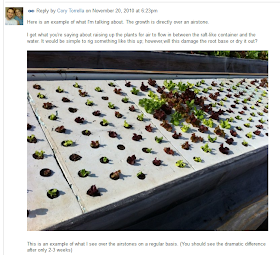I will say right up front that I don't know as much as some other people about aquaponic systems, but I am a General Building Contractor so I know how to build stuff and I have experience with green houses and gardening.
This post will be an ever expanding list of considerations for those who are attempting to build an aquaponic system based on what I have learned.
To start with here is some advice I just parted out to someone who is planning to build a green house.
The problem with green houses is over heating and freezing:
My advice would be not to glaze
the North side or North Roof. Very little light gain and a lot of
insulation lost.
If you live in a dry climate include evaporative cooling.
The sides and North wall should be insulated as heavily as you can
afford.
Place the fan as close to the peak as possible. Squirrel cage fans
move the most air. Stone or brick walls are good for thermal mass and
will help even the temperature swings. Water barrels are even better,
but thermal mass is not as effective as insulation in controlling the
environment and water barrels take up a lot of space.
My grow room is insulated with R19 walls and ceiling, the floor is insulated with R7.5 over a slab, and the tanks are insulated with R11 on all sides. Total area glazed is 40 sq. ft.with single pane glass.
The grow bed is 25 sq. ft. adjacent to the window.
1000 gallons of water in the tanks helps to keep the temperature steady. Currently it is Spring and we have daytime temperatures of 90F and night time near 65F. By ventilating during the night I have been able to maintain a tank temperature of 70F-75F.
When it gets hot I open the windows I used to use an evaporative cooling system, but the electrical expense was too high and I found that simply opening the windows was enough. In the winter outside temperature range from 20 to 60F and I used about 17KWper day to maintain 72F in the tanks. That was last year. I am currently switching out my tilapia for catfish which do well in a cool water tank. The goal is to grow food not waste money and energy doing it.
Here is a
simple inexpensive green house design.
Sump Tanks:
Sump tanks are good.
Sump tanks make maintenance easier, help maintain temperature, allow a constant water level in the fish tank.
Hydroton / Expanded Shale:
One thing that I find valuable about Hydroton and
Expanded Shale grow medium is
Neutral PH and No Buffering.
Inert is a KEY advantage.
When problems occur we always look at PH and if you don't know what
affect the medium is having on the buffering then it adds one more
unknown element to the problem.
Another advantage of Hydroton is that you can move your hands down into it. This is great for transplanting. Crushed rock is very hard on your hands and nails. While it's not as good as Hydroton, adding some pea gravel to crushed rock will make it easier.
A disadvantage of Hydroton is that most of it floats.
Expanded Shale on the other hand will not float.
PH and water chemistry and nutrients:
I may need correcting here but my motto is don't fuss with it if you don't need to. Chelated Iron is about all you should have to add, but if the PH is above 7.8 you may need to lower it in order for the chelated iron to be effective. Buffing from the growing media and local water supply may make the PH difficult to adjust.
GO SLOW.
Cycling:
Don't rush into placing fish until you have cycled the tank. Cycle the tank before purchasing fish. YES I repeated myself.
Cycle before adding fish!
Sick Fish:
SEA SALT cures a lot and is the least harmful treatment. More fish die from people who try to treat their fish than from disease.
More Information on SALT
Bell Siphons:
Use an air cap and a snorkel tube.
Click this line for more.
Self Built Tanks:
DO NOT UNDER ESTIMATE THE FORCES OF WATER!
 |
| Notice even this shallow tank is bowing from the pressure of water |
If you are not in construction or have little experience with engineering, then consult with someone whom you can trust. Your design may look strong, but the weight of water will destroy your tank while you stand in awe.
Under Ground Tanks
Where to Build:
I admire people who build their systems indoors. I've seen beautiful systems in the house, and some on hardwood floors! Maybe I'm just a klutz, but I think that's asking for trouble. I can't tell you how much water I've spilled. I'm not talking about the ever possible leak, I'm saying a lot of water gets spilled by accident, and I'd advise against building a system indoors.
Even if you are confident that you will never spill substantial amounts of water, then keep in mind the weight of system. House's are not built to hold several tons of anything in a small space
Air Stones:
Air is highly advantageous. It's good for fish and great for plants. Use lots of air!
This raft has one air stone in the water. Can you guess where?










